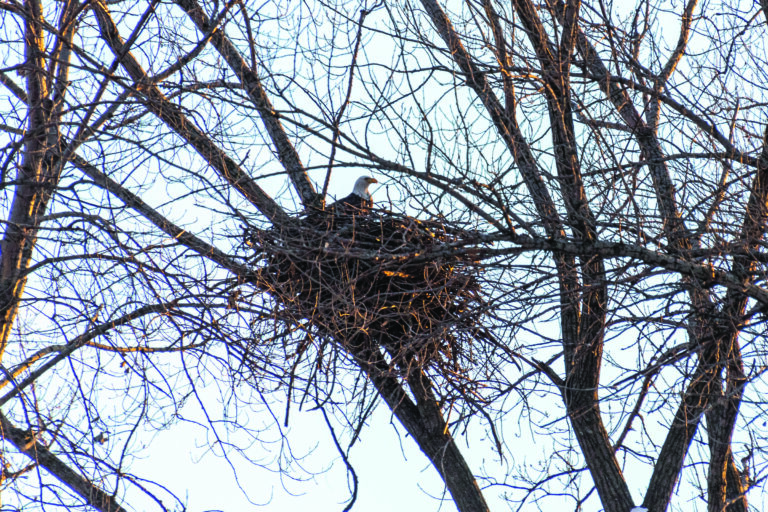
Jan Axelson
Northside News
Last fall visitors to Warner Park were delighted to notice a pair of bald eagles building a nest in the trees. Moira Kelley, who walks her dogs each day at Warner, reported, “On several occasions I had the opportunity to see the eagles, mid-flight, grab tree branches and carry them back to the nest.”
Eagles typically build nests of sticks high in a sturdy tree near a source of fish. Grasses, feathers and other soft materials fill the cracks and line the nest.
Egg laying occurs in late March or early April. The female typically lays two eggs, which hatch after about five weeks. After hatching, the parents carry fish and other food to the nestlings. After two or three months, the eaglets are ready to begin exploring the world around them. The parents continue to watch over the eaglets for a time after they leave the nest.
Mature bald eagles have wingspans of 6‒8 feet. It takes about five years for the birds to attain the familiar white head and tail of a mature eagle.
In 1973 Wisconsin had just 108 documented eagle nests. The low number was due in part to the pesticide DDT, which washed into waterways and contaminated fish. Eagles who ate the fish produced thin eggshells that broke or failed to hatch. Hunting and habitat loss also contributed to reduced eagle numbers.
Populations rebounded after the banning of DDT, the ending of eagle hunting, and increased protection of natural areas. In 2019 Wisconsin had 1,684 documented nests that were found in almost every county.
As Wild Warner Chair Kathlean Wolfe reflects, the nesting activity at Warner shows that “we have a park with enough good habitat that these eagles consider it worth living here. It’s a reflection of the focus of our community on nature having a central place in our park and in our lives.”
Good spots to view the nest are along the shoreline near the Rainbow Shelter and south of Forster Drive near Becker Drive. Look in the trees across the lagoon, near treetop level.
While bald eagles are no longer considered threatened or endangered, the Federal Bald and Golden Eagle Protection Act forbids disturbing eagles and their nests. Drew Cashman from Madison Audubon’s Bald Eagle Nest Watch program recommends staying at least 350 feet from the nest tree. Please respect park signage marking this boundary.
Cherokee Marsh has been home to an eagle nest in recent years. Possibly the Warner Park pair includes an offspring from that nest.